The question is already answered... but I wanted to show how to add shadow and change the font with NSAttributedString as well, so that when people search for this topic they won't have to keep looking.
#define FONT_SIZE 20
#define FONT_HELVETICA @"Helvetica-Light"
#define BLACK_SHADOW [UIColor colorWithRed:40.0f/255.0f green:40.0f/255.0f blue:40.0f/255.0f alpha:0.4f]
NSString*myNSString = @"This is my string.\nIt goes to a second line.";
NSMutableParagraphStyle *paragraphStyle = [[NSMutableParagraphStyle alloc] init];
paragraphStyle.alignment = NSTextAlignmentCenter;
paragraphStyle.lineSpacing = FONT_SIZE/2;
UIFont * labelFont = [UIFont fontWithName:FONT_HELVETICA size:FONT_SIZE];
UIColor * labelColor = [UIColor colorWithWhite:1 alpha:1];
NSShadow *shadow = [[NSShadow alloc] init];
[shadow setShadowColor : BLACK_SHADOW];
[shadow setShadowOffset : CGSizeMake (1.0, 1.0)];
[shadow setShadowBlurRadius : 1];
NSAttributedString *labelText = [[NSAttributedString alloc] initWithString : myNSString
attributes : @{
NSParagraphStyleAttributeName : paragraphStyle,
NSKernAttributeName : @2.0,
NSFontAttributeName : labelFont,
NSForegroundColorAttributeName : labelColor,
NSShadowAttributeName : shadow }];
Here is a Swift version...
Warning!
This works for 4s.
For 5s you have to change all of the the Float values to Double values (because the compiler isn't working correctly yet)
Swift enum for font choice:
enum FontValue: Int {
case FVBold = 1 , FVCondensedBlack, FVMedium, FVHelveticaNeue, FVLight, FVCondensedBold, FVLightItalic, FVUltraLightItalic, FVUltraLight, FVBoldItalic, FVItalic
}
Swift array for enum access (needed because enum can't use '-'):
func helveticaFont (index:Int) -> (String) {
let fontArray = [
"HelveticaNeue-Bold",
"HelveticaNeue-CondensedBlack",
"HelveticaNeue-Medium",
"HelveticaNeue",
"HelveticaNeue-Light",
"HelveticaNeue-CondensedBold",
"HelveticaNeue-LightItalic",
"HelveticaNeue-UltraLightItalic",
"HelveticaNeue-UltraLight",
"HelveticaNeue-BoldItalic",
"HelveticaNeue-Italic",
]
return fontArray[index]
}
Swift attributed text function:
func myAttributedText (myString:String, mySize: Float, myFont:FontValue) -> (NSMutableAttributedString) {
let shadow = NSShadow()
shadow.shadowColor = UIColor.textShadowColor()
shadow.shadowOffset = CGSizeMake (1.0, 1.0)
shadow.shadowBlurRadius = 1
let paragraphStyle = NSMutableParagraphStyle.alloc()
paragraphStyle.lineHeightMultiple = 1
paragraphStyle.lineBreakMode = NSLineBreakMode.ByWordWrapping
paragraphStyle.alignment = NSTextAlignment.Center
let labelFont = UIFont(name: helveticaFont(myFont.toRaw()), size: mySize)
let labelColor = UIColor.whiteColor()
let myAttributes :Dictionary = [NSParagraphStyleAttributeName : paragraphStyle,
NSKernAttributeName : 3, // (-1,5)
NSFontAttributeName : labelFont,
NSForegroundColorAttributeName : labelColor,
NSShadowAttributeName : shadow]
let myAttributedString = NSMutableAttributedString (string: myString, attributes:myAttributes)
// add new color
let secondColor = UIColor.blackColor()
let stringArray = myString.componentsSeparatedByString(" ")
let firstString: String? = stringArray.first
let letterCount = countElements(firstString!)
if firstString {
myAttributedString.addAttributes([NSForegroundColorAttributeName:secondColor], range:NSMakeRange(0,letterCount))
}
return myAttributedString
}
first and last extension used for finding ranges in a string array:
extension Array {
var last: T? {
if self.isEmpty {
NSLog("array crash error - please fix")
return self [0]
} else {
return self[self.endIndex - 1]
}
}
}
extension Array {
var first: T? {
if self.isEmpty {
NSLog("array crash error - please fix")
return self [0]
} else {
return self [0]
}
}
}
new colors:
extension UIColor {
class func shadowColor() -> UIColor {
return UIColor(red: 0.0/255.0, green: 0.0/255.0, blue: 0.0/255.0, alpha: 0.3)
}
class func textShadowColor() -> UIColor {
return UIColor(red: 50.0/255.0, green: 50.0/255.0, blue: 50.0/255.0, alpha: 0.5)
}
class func pastelBlueColor() -> UIColor {
return UIColor(red: 176.0/255.0, green: 186.0/255.0, blue: 255.0/255.0, alpha: 1)
}
class func pastelYellowColor() -> UIColor {
return UIColor(red: 255.0/255.0, green: 238.0/255.0, blue: 140.0/255.0, alpha: 1)
}
}
my macro replacement:
enum MyConstants: Float {
case CornerRadius = 5.0
}
my button maker w/attributed text:
func myButtonMaker (myView:UIView) -> UIButton {
let myButton = UIButton.buttonWithType(.System) as UIButton
myButton.backgroundColor = UIColor.pastelBlueColor()
myButton.showsTouchWhenHighlighted = true;
let myCGSize:CGSize = CGSizeMake(100.0, 50.0)
let myFrame = CGRectMake(myView.frame.midX - myCGSize.height,myView.frame.midY - 2 * myCGSize.height,myCGSize.width,myCGSize.height)
myButton.frame = myFrame
let myTitle = myAttributedText("Button",20.0,FontValue.FVLight)
myButton.setAttributedTitle(myTitle, forState:.Normal)
myButton.layer.cornerRadius = myButton.bounds.size.width / MyConstants.CornerRadius.toRaw()
myButton.setTitleColor(UIColor.whiteColor(), forState: .Normal)
myButton.tag = 100
myButton.bringSubviewToFront(myView)
myButton.layerGradient()
myView.addSubview(myButton)
return myButton
}
my UIView/UILabel maker w/attributed text, shadow, and round corners:
func myLabelMaker (myView:UIView) -> UIView {
let myFrame = CGRectMake(myView.frame.midX / 2 , myView.frame.midY / 2, myView.frame.width/2, myView.frame.height/2)
let mylabelFrame = CGRectMake(0, 0, myView.frame.width/2, myView.frame.height/2)
let myBaseView = UIView()
myBaseView.frame = myFrame
myBaseView.backgroundColor = UIColor.clearColor()
let myLabel = UILabel()
myLabel.backgroundColor=UIColor.pastelYellowColor()
myLabel.frame = mylabelFrame
myLabel.attributedText = myAttributedText("This is my String",20.0,FontValue.FVLight)
myLabel.numberOfLines = 5
myLabel.tag = 100
myLabel.layer.cornerRadius = myLabel.bounds.size.width / MyConstants.CornerRadius.toRaw()
myLabel.clipsToBounds = true
myLabel.layerborders()
myBaseView.addSubview(myLabel)
myBaseView.layerShadow()
myBaseView.layerGradient()
myView.addSubview(myBaseView)
return myLabel
}
generic shadow add:
func viewshadow<T where T: UIView> (shadowObject: T)
{
let layer = shadowObject.layer
let radius = shadowObject.frame.size.width / MyConstants.CornerRadius.toRaw();
layer.borderColor = UIColor.whiteColor().CGColor
layer.borderWidth = 0.8
layer.cornerRadius = radius
layer.shadowOpacity = 1
layer.shadowRadius = 3
layer.shadowOffset = CGSizeMake(2.0,2.0)
layer.shadowColor = UIColor.shadowColor().CGColor
}
view extension for view style:
extension UIView {
func layerborders() {
let layer = self.layer
let frame = self.frame
let myColor = self.backgroundColor
layer.borderColor = myColor.CGColor
layer.borderWidth = 10.8
layer.cornerRadius = layer.borderWidth / MyConstants.CornerRadius.toRaw()
}
func layerShadow() {
let layer = self.layer
let frame = self.frame
layer.cornerRadius = layer.borderWidth / MyConstants.CornerRadius.toRaw()
layer.shadowOpacity = 1
layer.shadowRadius = 3
layer.shadowOffset = CGSizeMake(2.0,2.0)
layer.shadowColor = UIColor.shadowColor().CGColor
}
func layerGradient() {
let layer = CAGradientLayer()
let size = self.frame.size
layer.frame.size = size
layer.frame.origin = CGPointMake(0.0,0.0)
layer.cornerRadius = layer.bounds.size.width / MyConstants.CornerRadius.toRaw();
var color0 = CGColorCreateGenericRGB(250.0/255, 250.0/255, 250.0/255, 0.5)
var color1 = CGColorCreateGenericRGB(200.0/255, 200.0/255, 200.0/255, 0.1)
var color2 = CGColorCreateGenericRGB(150.0/255, 150.0/255, 150.0/255, 0.1)
var color3 = CGColorCreateGenericRGB(100.0/255, 100.0/255, 100.0/255, 0.1)
var color4 = CGColorCreateGenericRGB(50.0/255, 50.0/255, 50.0/255, 0.1)
var color5 = CGColorCreateGenericRGB(0.0/255, 0.0/255, 0.0/255, 0.1)
var color6 = CGColorCreateGenericRGB(150.0/255, 150.0/255, 150.0/255, 0.1)
layer.colors = [color0,color1,color2,color3,color4,color5,color6]
self.layer.insertSublayer(layer, atIndex: 2)
}
}
the actual view did load function:
func buttonPress (sender:UIButton!) {
NSLog("%@", "ButtonPressed")
}
override func viewDidLoad() {
super.viewDidLoad()
let myLabel = myLabelMaker(myView)
let myButton = myButtonMaker(myView)
myButton.addTarget(self, action: "buttonPress:", forControlEvents:UIControlEvents.TouchUpInside)
viewshadow(myButton)
viewshadow(myLabel)
}

